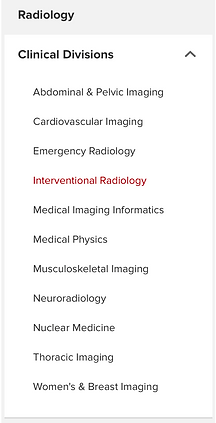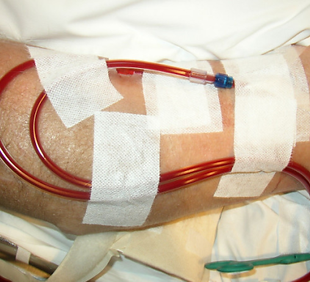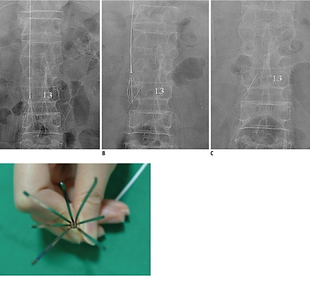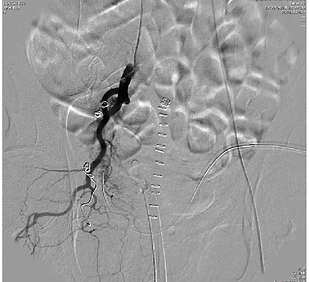


The Division of Interventional Radiology at The Ohio State University Wexner Medical Center uses imaging technology to diagnose and treat a myriad of disease processes within the body. Advanced image guidance allows for complex procedures to be performed through very small skin incisions. This results in decreased procedure-related and post-procedure pain, decreased risk of infection, decreased blood loss, and reduced recovery times. The clinical practice model adopted by the Division is one that builds upon the standard Interventional Radiology procedure services, and emphasizes the importance of the peri-procedural care of patients.
Interventional radiologists within the Division of Interventional Radiology are recognized experts and innovators in their field. They maintain strong collaborative relationships across departments and specialties in order to perform these minimally invasive procedures, each specifically tailored to the needs of the individual patient. Interventional procedures performed by the Division include:
-
Interventional oncology (radio-embolization, chemo-embolization, and percutaneous ablations)
-
Post-transplant interventions
-
Prostate artery embolization
Further, the Division of Interventional Radiology has built a procedure and vascular access team which has the ability to perform highly skilled procedures in the Interventional Radiology labs or at the patient’s bedside.
Procedures

Angiography
Angiography is performed to diagnose and treat arterial disease (narrowing, blockages, or injury). A small catheter is guided into the artery of interest through the groin or less commonly the arm. Contrast and X-rays are used to evaluate the arteries. If needed, arterial disease can be concurrently treated with balloon angioplasty, stent placement, or embolization (use of agents to block a vessel).

Biliary Drainage & Stenting
Biliary drainage and stenting are procedures performed to treat obstruction of the biliary ducts in the liver. A wire is inserted into the liver via a needle puncture. Ultrasound and x-rays are used to guide the wire into the bile duct. Contrast can be injected to outline the biliary ducts and identify any obstruction. A drainage tube is then placed to either drain the obstructed fluid internally or into an external bag.

Central Venous Access
Lines and ports are devices used to provide a way of giving regularly needed intravenous (IV) medications and treatments. A thin and hollow plastic tube called a ‘catheter’ or ‘line’ is placed into a vein in the neck or the chest. A port is another similar device that has a reservoir and is typically used for chemotherapy. These devices can stay there safely longterm. This has the advantage of not needing further IV access sites or repeated injections. Some reasons to have access to a central vein is for IV antibiotic treatment, chemotherapy, or anti-cancer drugs, hemodialysis for patients with poor kidney function, or even blood transfusions.

Chemoembolization (TACE)
Chemoembolization is a procedure used to treat tumors in the liver. A small catheter is placed into an artery in the groin and is advanced into the vessels supplying blood to the liver. Once the catheter is placed, chemotherapeutic agents are delivered to the site of the tumor. Additionally, the blood vessels are partially blocked which prevents the tumor from receiving blood supply. This dual-purpose procedure can result in significant tumor shrinkage.

Dialysis Access & Maintenance
Fistulas and grafts are used for routine dialysis access in patients with kidney failure. Over time, dialysis access can become clotted or narrow, which makes it hard to use for routine dialysis. This access portal can also be reopened by our interventional radiologists. Our team uses balloons, stents, and other devices to treat narrowing of the dialysis portal.

Gastrostomy/
Gastrojejunostomy Tubes
Gastrostomy and gastrojejunostomy tubes are commonly referred to as a G- or GJ-tubes. These tubes are placed in the abdomen to give direct access to the stomach and bowell for supplemental feeding, hydration, or medication administration.

IVC Filter Placement & Retrieval
An inferior vena cava (IVC) filter is a filter-like device placed in the IVC (major blood vessel in the body) to stop blood clots in the legs from reaching the heart and lungs. The IVC filter traps the blood clots in the vein before they can reach the heart. Interventional radiologists can place IVC filters be inserting a small catheter into the neck or groin veins. They inject contrast dye into the veins to find their way to the IVC. Once in position, the filter is released and attaches to the IVC vein walls. When it is time for the IVC filter to come out, our interventional radiologists use a similar method with catheters to reach the IVC filter. A small hook is attached to the filter to pull it out of the vein with the catheter.

Paracentesis
Paracentesis is a procedure performed using ultrasound to locate a pocket of free fluid in the abdominal cavity, also known as ascites. After identifying fluid is present and finding a safe location, a needle with a sheath is inserted and fluid is removed through the sheath. This procedure can be done to diagnose the cause of fluid buildup or as treatment to relieve discomfort from the large amount of fluid in the abdominal space.

Transjugular intrahepatic portosystemic shunt (TIPS)
Transjugular intrahepatic portosystemic shunt (TIPS) is a procedure that involves the creation of a new blood vessel in the liver of patients with cirrhosis (liver scarring). This relieves the pressure of blood flowing through the diseased liver and can help stop bleeding and fluid build-up. TIPS may successfully reduce internal bleeding in the stomach and esophagus in patients with cirrhosis and may also reduce the accumulation of fluid in the abdomen.

Prostatic Artery Embolization
Prostatic artery embolization is used to treat benign prostate hyperplasia (BPH), which often results in uncomfortable urinary symptoms, such as blocking the flow of urine out of the bladder in older men. A small catheter is placed into an artery in the groin and is advanced into the vessels supplying the prostate. Microscopic beads are then released to block off the blood flow that’s causing the enlargement in the prostate and help with the symptoms.

Uterine Fibroid Embolization
Uterine fibroid embolization is a minimally-invasive procedure used to treat fibroids of the uterus, which can cause heavy menstrual bleeding, pain, and pressure on the bladder or bowel. A small catheter is placed into an artery in the groin and is advanced into the vessels supplying the fibroids in the uterus. Microscopic beads are then released to block off the blood flow that’s causing the enlargement of the fibroids causing them to shrink and help with the symptoms.

Thoracentesis
Thoracentesis is a procedure performed to diagnose and treat pleural effusions, a condition in which excess fluid build-up in the chest. Thoracentesis involves the placement of small needle under ultrasound-guidance into the chest for obtaining a sample or draining the fluid. Thoracentesis helps determine the cause of the excess fluid. It also helps ease any shortness of breath or pain by removing the fluid and relieving pressure on the lungs.
Angiography
Angiography is performed to diagnose and treat arterial disease (narrowing, blockages, or injury). A small catheter is guided into the artery of interest through the groin or less commonly the arm. Contrast and X-rays are used to evaluate the arteries. If needed, arterial disease can be concurrently treated with balloon angioplasty, stent placement, or embolization (use of agents to block a vessel).
Biliary Drainage & Stenting
Biliary drainage and stenting are procedures performed to treat obstruction of the biliary ducts in the liver. A wire is inserted into the liver via a needle puncture. Ultrasound and x-rays are used to guide the wire into the bile duct. Contrast can be injected to outline the biliary ducts and identify any obstruction. A drainage tube is then placed to either drain the obstructed fluid internally or into an external bag.
Central Venous Access
Lines and ports are devices used to provide a way of giving regularly needed intravenous (IV) medications and treatments. A thin and hollow plastic tube called a ‘catheter’ or ‘line’ is placed into a vein in the neck or the chest. A port is another similar device that has a reservoir and is typically used for chemotherapy. These devices can stay there safely longterm. This has the advantage of not needing further IV access sites or repeated injections. Some reasons to have access to a central vein is for IV antibiotic treatment, chemotherapy, or anti-cancer drugs, hemodialysis for patients with poor kidney function, or even blood transfusions.
Chemoembolization (TACE)
Chemoembolization is a procedure used to treat tumors in the liver. A small catheter is placed into an artery in the groin and is advanced into the vessels supplying blood to the liver. Once the catheter is placed, chemotherapeutic agents are delivered to the site of the tumor. Additionally, the blood vessels are partially blocked which prevents the tumor from receiving blood supply. This dual-purpose procedure can result in significant tumor shrinkage.
Dialysis Access & Maintenance
Fistulas and grafts are used for routine dialysis access in patients with kidney failure. Over time, dialysis access can become clotted or narrow, which makes it hard to use for routine dialysis. This access portal can also be reopened by our interventional radiologists. Our team uses balloons, stents, and other devices to treat narrowing of the dialysis portal.
Gastrostomy/Gastrojejunostomy Tubes
Gastrostomy and gastrojejunostomy tubes are commonly referred to as a G- or GJ-tubes. These tubes are placed in the abdomen to give direct access to the stomach and bowell for supplemental feeding, hydration, or medication administration.
IVC Filter Placement & Retrieval
An inferior vena cava (IVC) filter is a filter-like device placed in the IVC (major blood vessel in the body) to stop blood clots in the legs from reaching the heart and lungs. The IVC filter traps the blood clots in the vein before they can reach the heart. Interventional radiologists can place IVC filters be inserting a small catheter into the neck or groin veins. They inject contrast dye into the veins to find their way to the IVC. Once in position, the filter is released and attaches to the IVC vein walls. When it is time for the IVC filter to come out, our interventional radiologists use a similar method with catheters to reach the IVC filter. A small hook is attached to the filter to pull it out of the vein with the catheter.
Paracentesis
Paracentesis is a procedure performed using ultrasound to locate a pocket of free fluid in the abdominal cavity, also known as ascites. After identifying fluid is present and finding a safe location, a needle with a sheath is inserted and fluid is removed through the sheath. This procedure can be done to diagnose the cause of fluid buildup or as treatment to relieve discomfort from the large amount of fluid in the abdominal space.
Biopsies
The biopsy procedure involves the insertion of a needle into a suspected lesion or an organ with the aim to obtain cells or tissue for diagnosis. It’s a relatively non-invasive procedure and is performed under the guidance of x-rays, ultrasound, or CT.
Prostatic Artery Embolization
Prostatic artery embolization is used to treat benign prostate hyperplasia (BPH), which often results in uncomfortable urinary symptoms, such as blocking the flow of urine out of the bladder in older men. A small catheter is placed into an artery in the groin and is advanced into the vessels supplying the prostate. Microscopic beads are then released to block off the blood flow that’s causing the enlargement in the prostate and help with the symptoms.
TIPS
Transjugular intrahepatic portosystemic shunt (TIPS) is a procedure that involves the creation of a new blood vessel in the liver of patients with cirrhosis (liver scarring). This relieves the pressure of blood flowing through the diseased liver and can help stop bleeding and fluid build-up. TIPS may successfully reduce internal bleeding in the stomach and esophagus in patients with cirrhosis and may also reduce the accumulation of fluid in the abdomen.
Thoracentesis
Thoracentesis is a procedure performed to diagnose and treat pleural effusions, a condition in which excess fluid build-up in the chest. Thoracentesis involves the placement of small needle under ultrasound-guidance into the chest for obtaining a sample or draining the fluid. Thoracentesis helps determine the cause of the excess fluid. It also helps ease any shortness of breath or pain by removing the fluid and relieving pressure on the lungs.
Uterine Fibroid Embolization
Uterine fibroid embolization is a minimally-invasive procedure used to treat fibroids of the uterus, which can cause heavy menstrual bleeding, pain, and pressure on the bladder or bowel. A small catheter is placed into an artery in the groin and is advanced into the vessels supplying the fibroids in the uterus. Microscopic beads are then released to block off the blood flow that’s causing the enlargement of the fibroids causing them to shrink and help with the symptoms.
Describe the item and include any relevant details. Click to edit the text.
